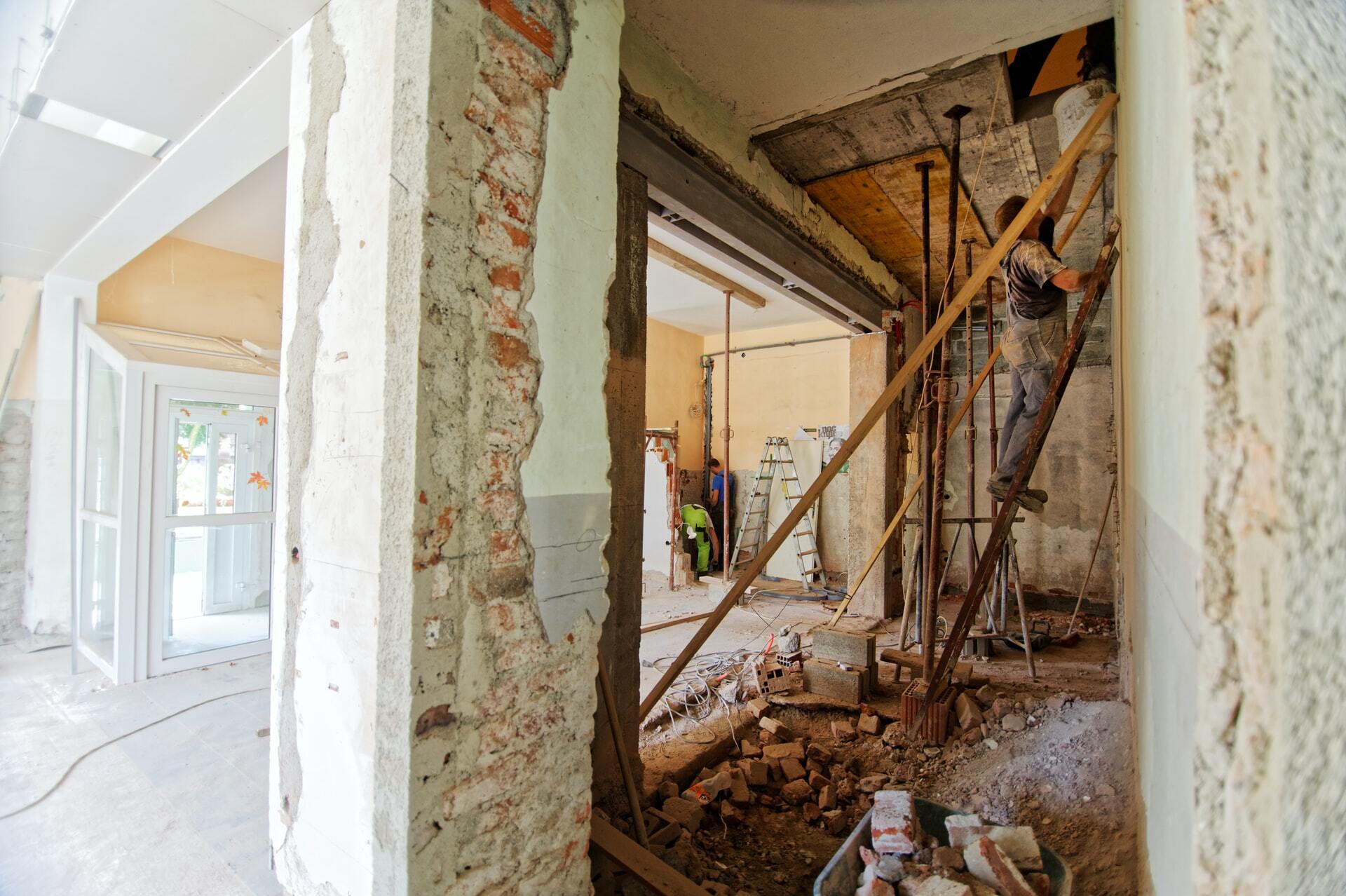Home>diy>Home Improvement>How Long Does A Full Home Renovation Take


Home Improvement
How Long Does A Full Home Renovation Take
Modified: December 7, 2023
Looking to improve your home? Discover how long a full home renovation takes and plan your project accordingly with our expert tips and guidance.
(Many of the links in this article redirect to a specific reviewed product. Your purchase of these products through affiliate links helps to generate commission for Storables.com, at no extra cost. Learn more)
Introduction
Welcome to the world of home renovations! Whether you are looking to transform your cozy cottage into a modern masterpiece or give your outdated kitchen a sleek and stylish makeover, a full home renovation is an exciting and rewarding project. However, before you embark on this journey, it’s essential to understand the time commitments involved. In this article, we will explore the factors that affect the duration of a full home renovation and provide you with a comprehensive timeline to help you plan accordingly.
Renovating your entire home requires careful planning, skilled labor, and coordination of various tradespeople. From obtaining permits and approvals to the final touches and cleanup, each phase of the renovation process plays a crucial role in achieving your desired outcome. By understanding the steps involved and the approximate timeframes for each, you can set realistic expectations and ensure a smooth and successful renovation experience.
So, let’s dive in and explore the factors that can affect the duration of a full home renovation!
Key Takeaways:
- Embarking on a full home renovation journey requires careful planning, skilled labor, and open communication. Flexibility is key as unexpected challenges may arise, so stay organized and enjoy the exciting journey of turning your house into a cherished home.
- From obtaining permits and approvals to the final touches and cleanup, a successful home renovation goes beyond the completion of construction. Attention to detail, quality craftsmanship, and open communication are essential to ensure a smooth and successful renovation experience.
Read more: How Long Does A Full Gut Renovation Take
Factors Affecting the Duration of a Full Home Renovation
When it comes to a full home renovation, several factors can affect the overall duration of the project. Understanding these factors can help you plan your renovation timeline more effectively and avoid any unexpected delays. Let’s take a closer look at some key factors that can impact the duration:
- Size and Scope of the Renovation: The size and complexity of your renovation project will have a significant impact on how long it takes to complete. A minor renovation, such as updating a single room, will generally take less time compared to a major renovation involving multiple areas of your home.
- Structural Changes: If your renovation involves structural changes, such as removing or adding walls, it will add more time to the project. Structural changes often require careful planning, engineering assessments, and obtaining necessary permits.
- Permits and Approvals: The time required to obtain permits and approvals from local authorities can vary from region to region. Depending on your location and the complexity of your renovation, it may take several weeks to get all the necessary permits in place.
- Availability of Contractors and Tradespeople: The availability of skilled contractors and tradespeople can impact the timeline of your renovation. It’s important to work with reputable professionals who can commit to the project and complete the work within the agreed timeframe.
- Weather Conditions: If your renovation involves exterior work, such as roofing or landscaping, weather conditions can be a significant factor. Inclement weather can delay outdoor projects, so it’s important to consider the seasonal impact when planning your renovation timeline.
- Unforeseen Issues: Despite careful planning, there may be unforeseen issues that arise during the renovation process. This could include hidden structural problems, plumbing or electrical issues, or unexpected delays in material delivery. These unforeseen issues can potentially extend the project timeline.
By taking these factors into consideration, you can better estimate the duration of your full home renovation. It’s important to remember that while a well-planned renovation can proceed smoothly, there may still be unforeseen circumstances that can cause delays. Flexibility and open communication with your contractors will help navigate any challenges that may arise during the renovation process.
Now that we’ve explored the factors that can affect the duration of a full home renovation, let’s move on to the planning phase, where the groundwork for your renovation project begins.
Planning Phase
The planning phase is a crucial step in any home renovation project. It lays the foundation for a successful and well-executed renovation by ensuring that all aspects of the project are carefully considered and planned out. During this phase, you will work with your design team or contractors to discuss your goals, assess your budget, and create a detailed plan for the renovation.
Here are some key steps involved in the planning phase:
- Define Your Goals: Start by clearly identifying your renovation goals. Do you want to create an open-concept living space, upgrade your kitchen, or add an additional bedroom? Having a clear vision of what you want to achieve will guide the rest of the planning process.
- Set a Realistic Budget: Determine how much you are willing to invest in your renovation project. Consider factors such as the overall value of your home, the expected return on investment, and any financing options you have. Having a realistic budget will help guide your decisions and ensure you don’t overspend.
- Hire a Design Team or Contractor: If your renovation involves significant changes or requires architectural expertise, it’s advisable to hire a design team or architect. They will help you create detailed plans, navigate building codes and regulations, and provide valuable insights throughout the process. If your renovation is more straightforward, hiring a reputable contractor may be sufficient.
- Create a Detailed Plan: Work closely with your design team or contractor to create a detailed plan for your renovation. This plan should include architectural drawings, a list of materials and finishes, and a timeline for each phase of the project.
- Obtain Quotes and Compare: Reach out to multiple contractors or suppliers to obtain quotes for the work. Compare these quotes based on both cost and reputation to ensure you are getting a fair price and working with experienced professionals.
- Secure Financing and Permits: If required, secure financing for your renovation and ensure you have all the necessary permits and approvals in place before starting the project. Working with a reputable contractor can help guide you through this process.
Remember, the planning phase is a collaborative effort between you, your design team or contractor, and any professionals involved in the renovation. Open communication, attention to detail, and flexibility are key during this phase to ensure everyone is aligned on the project goals and timelines.
Once the planning phase is complete, and you have a clear roadmap for your renovation, it’s time to move onto obtaining the necessary permits and approvals before any construction work can begin.
Obtaining Permits and Approvals
Before embarking on any construction work for your home renovation, it is essential to obtain the necessary permits and approvals from local authorities. These permits ensure that your renovation project complies with building codes and regulations, and that it is safe and structurally sound.
Here are the key steps involved in obtaining permits and approvals:
- Research Local Regulations: Start by researching the specific permits and approvals required for your renovation project in your local area. Building codes can vary, so it’s important to understand what is needed for your specific project.
- Submit Applications: Once you have a clear understanding of the permits and approvals required, submit the necessary applications to the appropriate local authorities. This may include building permits, zoning approvals, and any other specific permits based on the nature of your renovation.
- Prepare Supporting Documents: Along with the permit applications, you may need to provide supporting documents such as architectural drawings, engineering reports, and contractor information. Ensure that all the required documents are complete and accurate to avoid any delays in the approval process.
- Pay Fees: There are usually fees associated with permit applications. Make sure to pay these fees promptly to avoid any delays in the approval process.
- Obtain Approvals: Once your applications are submitted, the authorities will review the documents and conduct inspections, if necessary. This process can take several weeks or even months, depending on the complexity of your project and the workload of the local authorities. Patience is key during this stage.
- Address Feedback and Modifications: In some cases, the reviewing authority may provide feedback or request modifications to your plans. Work closely with your design team or contractor to address any feedback and make the necessary changes to your plans if required.
- Finalize Approvals: Once all the necessary inspections and modifications are completed, you will receive the final approvals for your renovation project. These approvals give you the green light to proceed with your construction work.
It’s important to note that commencing construction without the proper permits and approvals can result in legal consequences and potentially halt your renovation project. It’s always best to ensure that you have obtained all the necessary permissions before starting any work.
Now that you have obtained the permits and approvals, it’s time to move on to the actual construction phase of your full home renovation. In the next section, we will discuss the significant steps involved in demolition and site preparation.
Demolition and Site Preparation
Once you have obtained the necessary permits and approvals, it’s time to begin the exciting phase of demolition and site preparation for your home renovation. This phase involves clearing out the existing structures and preparing the site for the upcoming construction work. It sets the stage for the transformation of your home.
Here are the key steps involved in the demolition and site preparation phase:
- Clearing the Space: The first step is to remove any furniture, fixtures, and belongings from the area that will undergo renovation. This includes disconnecting utilities such as electricity, water, and gas.
- Structural Demolition: If there are any walls, partitions, or structures that need to be removed or modified, the demolition process begins. This typically involves using tools and machinery to safely and efficiently demolish and remove unwanted structures.
- Waste Removal: As the demolition progresses, the debris and waste generated need to be properly disposed of. This may involve hiring a waste removal company or renting a dumpster to accommodate the waste materials.
- Asbestos and Hazardous Material Removal: In older homes, it’s possible that asbestos or other hazardous materials may be present. It’s crucial to engage professionals to safely remove and dispose of these materials according to regulations.
- Site Preparation: Once the space is cleared, the site needs to be prepared for the upcoming construction work. This may involve leveling the ground, preparing the foundation, or making any necessary adjustments to the existing structure.
- Protecting Other Areas: During demolition and site preparation, it is essential to protect the unaffected areas of your home from dust, debris, and potential damage. Temporary barriers and coverings may be used to safeguard these areas.
- Inspections: During the site preparation phase, various inspections may be required to ensure compliance with building codes and regulations. These inspections help identify any potential issues that need to be addressed before moving forward.
The duration of the demolition and site preparation phase can vary depending on the size and complexity of your project. It’s important to work closely with your contractors and design team to ensure that this phase is completed efficiently and safely.
Once the demolition and site preparation phase is complete, the next steps involve structural changes and renovations. In the following section, we will discuss these crucial components of a full home renovation.
Structural Changes and Renovations
Now that the site has been prepared, it’s time to dive into the exciting phase of making structural changes and renovations to your home. This phase involves any major alterations to the existing layout, such as removing or adding walls, creating new openings, or modifying the structural elements of your home.
Here are the key steps involved in the structural changes and renovations phase:
- Consult with Design Professionals: Work closely with your design team or architect to finalize the structural changes and renovations you want to make. They will help identify the scope of the work and provide guidance on the feasibility and structural implications.
- Demolition of Existing Walls or Structures: If there are walls or structures that need to be removed, the demolition process continues during this phase. Careful attention must be given to ensure that any necessary supports or reinforcements are put in place before removing load-bearing walls.
- Modifying Building Systems: As structural changes are made, it may be necessary to modify or relocate existing building systems, such as electrical wiring, plumbing, or HVAC ducts. This ensures that these systems are properly integrated into the new layout.
- Adding New Structural Elements: If your renovation involves adding new rooms, extensions, or additional levels, this phase will include the construction of the new structural elements. This may require the expertise of structural engineers to ensure the safety and integrity of the new additions.
- Inspecting and Reinforcing: Throughout the structural changes and renovations, inspections will be conducted to ensure compliance with building codes and regulations. In some cases, additional reinforcement may be required to support the changes made.
- Integrating Design Features: As the structural changes progress, it’s important to consider the aesthetic and design features that will enhance the visual appeal of the renovated space. This may include selecting materials, finishes, and architectural details.
The duration of the structural changes and renovations phase can vary significantly depending on the complexity of the alterations and the size of the project. It’s essential to work closely with your contractors, architects, and engineers to ensure that the structural changes are executed correctly and safely.
Once the structural changes and renovations are complete, the focus shifts to the installation of plumbing and electrical systems. In the next section, we will explore these vital components of a full home renovation.
A full home renovation can take anywhere from 3 months to a year, depending on the scope of the project and the availability of materials and contractors. It’s important to plan for unexpected delays and budget accordingly.
Plumbing and Electrical Work
As the structural changes and renovations phase nears completion, it’s time to shift the focus towards the installation of plumbing and electrical systems. The plumbing and electrical work are crucial components of any home renovation project, as they ensure the functionality, safety, and convenience of your home.
Here are the key steps involved in the plumbing and electrical work phase:
- Planning and Design: Work closely with your contractors, plumbers, and electricians to plan and design the layout of the plumbing and electrical systems. Ensure that the design aligns with your needs and complies with building codes and safety regulations.
- Upgrading Plumbing Systems: If you are renovating the kitchen or bathroom, it may involve upgrading or relocating plumbing fixtures such as sinks, toilets, showers, and bathtubs. This requires experienced plumbers to ensure proper installation and functionality.
- Installing New Plumbing Lines: If you are making significant changes to the layout of your home, it may involve installing new plumbing lines. This may include water supply lines, drain lines, and vent pipes. These lines must be properly installed to ensure efficient and leak-free plumbing.
- Electrical Wiring and Outlets: During this phase, electricians will install and connect the electrical wiring throughout your home. This includes wiring for lighting fixtures, outlets, switches, and any additional electrical components specific to your renovation.
- Upgrading Electrical Panels: Depending on the scale of your renovation, it may be necessary to upgrade your electrical panel to accommodate the increased electrical load. This ensures that your home’s electrical system can safely handle the new electrical requirements.
- Testing and Inspections: Once the plumbing and electrical work is complete, it is important to conduct thorough testing to ensure that all fixtures, connections, and wiring are functioning properly and safely. Inspections by local authorities may also be required to ensure compliance with building codes.
The duration of the plumbing and electrical work phase can vary based on the complexity of the systems being installed or upgraded. It’s crucial to work with experienced and licensed professionals to ensure that the plumbing and electrical work is done correctly and meets all safety standards.
With the plumbing and electrical work complete, the next phase involves the installation of flooring, walls, and ceilings. In the following section, we will explore these essential elements of a full home renovation.
Flooring, Walls, and Ceiling Installation
With the plumbing and electrical work completed, it’s time to shift your focus to the installation of flooring, walls, and ceilings. These elements play a crucial role in the overall aesthetics and functionality of your newly renovated home. Whether you’re upgrading your floors, revamping your walls, or adding a new ceiling design, this phase will bring your vision to life.
Here are the key steps involved in the flooring, walls, and ceiling installation phase:
- Choosing Flooring Materials: Start by selecting the type of flooring you desire, whether it’s hardwood, tile, carpet, or laminate. Consider factors such as durability, maintenance, and the overall style you want to achieve.
- Preparing Subfloor: If you’re installing new flooring, the existing subfloor may need to be prepared. This involves cleaning, repairing any damages, or applying leveling compounds if necessary.
- Installing Flooring: Once the subfloor is ready, the installation process begins. This may involve laying down tiles, applying adhesive for carpeting, or using nails or glue for wood or laminate flooring. Proper installation techniques and accuracy are vital for achieving a seamless and long-lasting result.
- Wall Renovations: If you’re planning to modify or upgrade your walls, this is the time to do so. It could involve drywall installations, applying plaster or texture, or using decorative wall panels. Dents or damages on existing walls can also be repaired at this stage.
- Painting and Wallpapering: Once the walls are prepared, you can paint or wallpaper them to achieve your desired look. Select colors and finishes that complement the overall design scheme of your home.
- Ceiling Installations: If you’re altering or adding a new ceiling design, this phase involves the installation of ceiling materials, such as drywall, ceiling tiles, or suspended ceilings. Proper installation is crucial to ensure stability and aesthetics.
- Finishing Touches: After the major installations, attention will be on adding finishing touches, such as baseboards, crown moldings, trims, and other decorative elements. These details enhance the overall appearance of the newly renovated space.
The duration of the flooring, walls, and ceiling installation phase can vary depending on the size of the area, complexity of the materials used, and any additional customization you have planned. It’s important to work closely with experienced contractors and suppliers to ensure a high-quality installation that meets your expectations.
With the flooring, walls, and ceiling installations complete, the final steps involve painting and finishing. In the next section, we will explore these final touches that bring your home renovation project to life.
Painting and Finishing
After the major installations of flooring, walls, and ceilings, it’s time to add the final touches that truly bring your home renovation project to life. This phase involves painting the walls, applying finishes, and adding any necessary detailing to create a polished and inviting space.
Here are the key steps involved in the painting and finishing phase:
- Paint Selection: Choose the colors and finishes for your walls that align with your design vision. Consider factors such as lighting, room size, and the overall mood you want to create.
- Preparing the Walls: Before painting, the walls need to be properly prepared. This involves filling in any holes or imperfections, sanding the surfaces, and ensuring a smooth and even base for painting.
- Priming: Applying a coat of primer to the walls helps create a uniform surface and improves the adhesion of paint. It also helps to cover any existing stains or discolorations.
- Paint Application: Once the walls are prepped and primed, it’s time to apply the paint. Use professional techniques and high-quality materials to achieve a smooth and flawless finish. Multiple coats may be necessary to achieve the desired color and coverage.
- Finishing Touches: In addition to painting, this phase also involves adding finishing touches such as trim and baseboards. Ensure that these elements are properly cut, aligned, and installed to enhance the overall look and feel of the space.
- Final Inspections: After the painting and finishing work is complete, it’s important to conduct a thorough inspection to ensure that all surfaces are properly painted, and any necessary touch-ups are made.
The duration of the painting and finishing phase will depend on the size of the space, the complexity of the design, and the labor involved. It’s important to allocate sufficient time for proper preparation and application for a beautiful and long-lasting finish.
With the painting and finishing complete, the final steps of cabinetry and fixture installation will bring functionality and style to your renovated space. We will explore these steps in detail in the following section.
Read more: How Long Does Insulation Take To Install
Cabinetry and Fixture Installation
As you near the completion of your home renovation project, the focus shifts towards the installation of cabinetry and fixtures. This phase adds the finishing touches and practicality to your newly renovated space, ensuring that it is both functional and visually appealing.
Here are the key steps involved in the cabinetry and fixture installation phase:
- Cabinet Planning and Design: Work with your design team or contractor to plan and design the layout of your cabinetry. Consider factors such as storage needs, style preferences, and the overall flow of the space.
- Custom Cabinet Construction: If you’ve opted for custom cabinetry, this phase involves the construction of the cabinets, including the cutting, shaping, and assembling of the materials. The cabinets are tailored to fit your specific space and design requirements.
- Preparation of Cabinetry Space: Before installing the cabinets, ensure that the designated space is prepared, including leveling countertops, making necessary adjustments to accommodate plumbing and electrical connections, and providing adequate support for the cabinets.
- Cabinet Installation: Professional installers will carefully position and secure the cabinets in their designated locations. Bracing, leveling, and ensuring proper alignment are critical to achieve a seamless and functional installation.
- Hardware and Fixture Installation: Once the cabinets are in place, it’s time to install the hardware, such as handles, knobs, and hinges, to add the final touches. Additionally, fixtures such as sinks, faucets, and appliances are installed to complete the functionality of the space.
- Adjustments and Alignment: Fine-tuning adjustments may be necessary after the installation to ensure that the cabinetry doors and drawers operate smoothly and align properly. This step ensures that all components of the cabinetry are functional and visually appealing.
The duration of the cabinetry and fixture installation phase will depend on the size and complexity of the cabinetry, the number of fixtures, and the intricacy of the design. It’s crucial to work with experienced professionals to ensure a precise and high-quality installation.
With the cabinetry and fixture installation complete, the final steps involve adding any remaining finishing touches and conducting a thorough cleanup. In the next section, we will explore these final touches and the cleanup process to bring your home renovation project to a close.
Final Touches and Cleanup
Congratulations! You’re nearing the completion of your home renovation project. The final touches and cleanup phase is where you add those extra details that make your space feel complete and ensure everything is in top-notch condition. This phase involves adding decorative elements, performing a thorough cleanup, and conducting final inspections to ensure everything meets your satisfaction.
Here are the key steps involved in the final touches and cleanup phase:
- Decorative Elements: Add the final decorative touches that will elevate the aesthetics of your renovated space. This can include hanging artwork, installing light fixtures, adding window treatments, or incorporating furniture and accessories to complete the overall design.
- Finishing Detailing: Take the time to examine your space for any minor imperfections or touch-ups that need to be addressed. This includes making adjustments to any loose fixtures, caulking gaps, and ensuring that all surfaces are clean and polished.
- Thorough Cleaning: Perform a thorough cleaning of the entire space, including all surfaces, floors, cabinets, and fixtures. Remove any construction debris, dust, or debris left over from the renovation process.
- Final Inspection: Conduct a comprehensive inspection of your newly renovated home. Check for any functional or cosmetic issues that still need to be addressed. Take note of any necessary repairs or adjustments and communicate them to your contractors for resolution.
- Punch List: Create a punch list detailing any remaining work that needs to be completed or corrected. This can include minor adjustments, touch-ups, or any outstanding tasks that were not completed during the renovation process.
- Final Walkthrough: Once the punch list items have been addressed, schedule a final walkthrough of your renovated space with your contractors. Ensure that everything has been completed to your satisfaction and any necessary revisions have been made.
The duration of the final touches and cleanup phase will depend on the size of your renovation project, the extent of the final detailing required, and the efficiency of your contractors. Allow sufficient time to ensure that all tasks are completed and your space is ready for you to enjoy.
With the final touches and cleanup complete, you can now happily step back and admire the beautiful transformation of your home. Congratulations on successfully completing your full home renovation! Enjoy your refreshed and revamped space for years to come.
Conclusion
Completing a full home renovation is an exciting and rewarding endeavor that can transform your living space into the home of your dreams. Throughout this journey, you have learned about the various factors that can affect the duration of a full home renovation, from the planning phase to obtaining permits and approvals, to the actual construction and finishing stages. By understanding these factors and following a well-organized timeline, you can ensure a smooth and successful renovation experience.
It’s important to remember that every home renovation project is unique, and the timeline will vary based on the size, complexity, and individual circumstances of your project. Flexibility is key as unexpected challenges may arise along the way. By working closely with experienced contractors, design professionals, and suppliers, you can navigate through any obstacles and achieve the desired outcome.
During the course of your full home renovation, attention to detail, quality craftsmanship, and open communication are essential. Take the time to carefully plan and design your vision, ensuring that all necessary permits and approvals are in place. Engage skilled professionals to carry out the various stages of the renovation, from demolition and structural changes to plumbing and electrical work, and the installation of flooring, walls, cabinetry, fixtures, and final touches. Pay attention to the finishing details to achieve a polished and functional end result.
Remember, a successful home renovation goes beyond the completion of construction. It’s important to conduct final inspections, address any outstanding issues, and perform a thorough cleanup to truly enjoy your new space. Celebrate your hard work and revel in the transformation of your home, knowing that it reflects your personal taste, style, and functionality.
By embarking on a full home renovation journey with proper planning, knowledge, and a thoughtful approach, you can create a living space that truly embodies your vision and exceeds your expectations. So, whether you’re transforming a small apartment or revamping an entire house, embrace the process, stay organized, and enjoy the exciting journey of turning your house into a cherished home.
Frequently Asked Questions about How Long Does A Full Home Renovation Take
Was this page helpful?
At Storables.com, we guarantee accurate and reliable information. Our content, validated by Expert Board Contributors, is crafted following stringent Editorial Policies. We're committed to providing you with well-researched, expert-backed insights for all your informational needs.














0 thoughts on “How Long Does A Full Home Renovation Take”